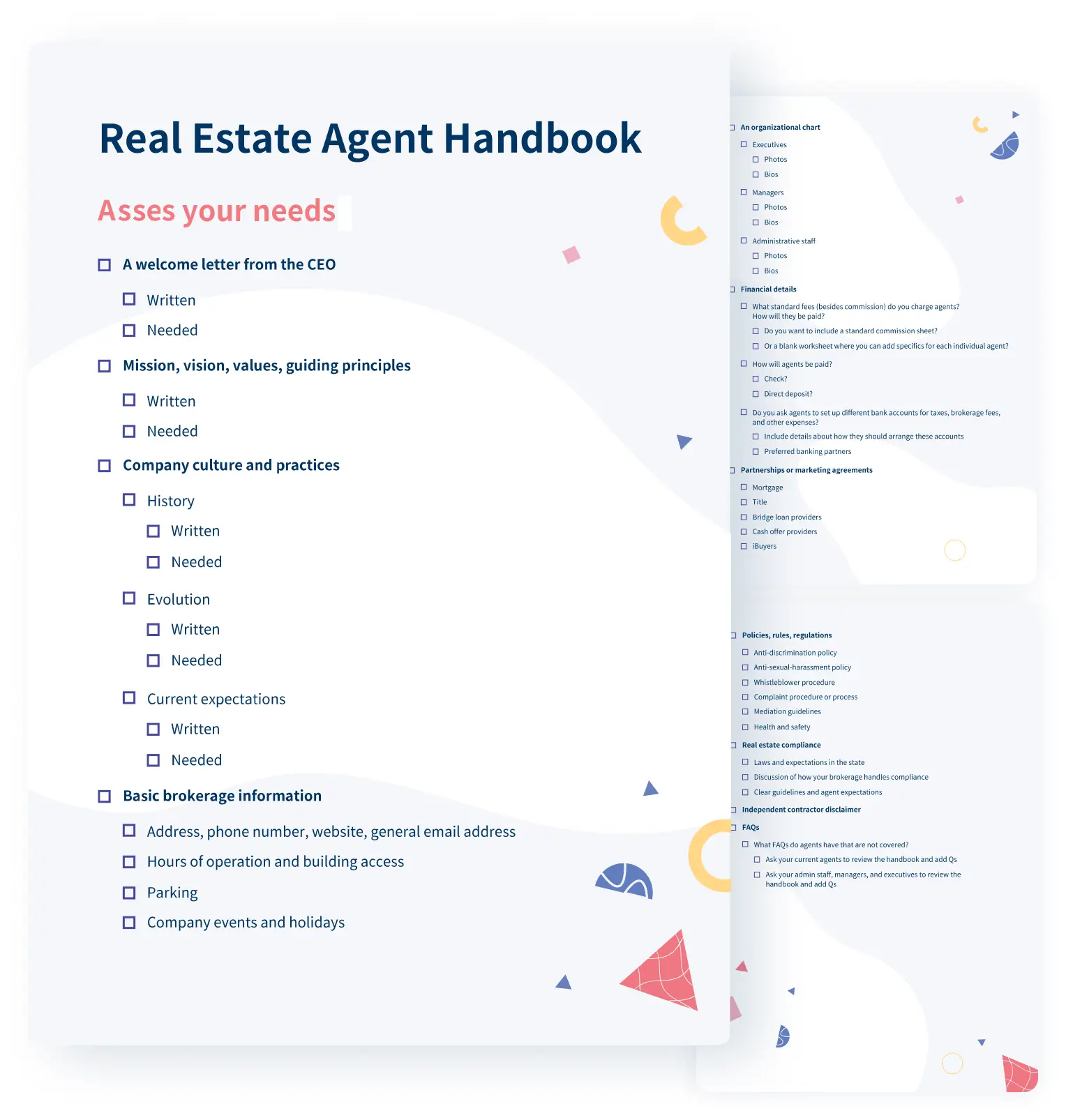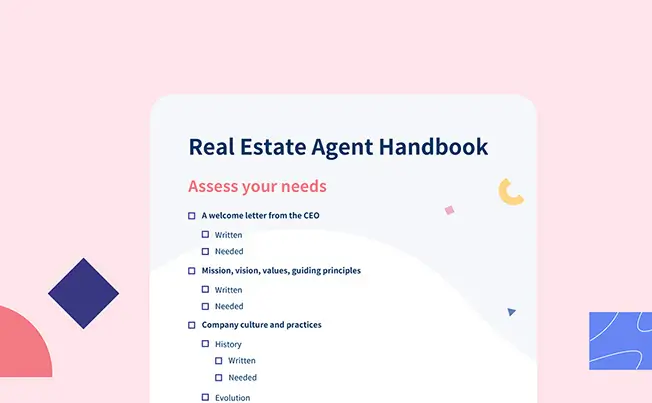A handbook for your new (and existing) agents gives them a reference point for what to expect at your brokerage—and putting time and energy into a resource that orients and welcomes your agents shows those agents how much you care about them, and how much you’re willing to invest in their success.
Don’t have an agent handbook? This quick guide will help get you started.
Step 1: Assess your needs
Your real estate agent handbook should include the following components. Do you have these ready? Note what’s available and what needs to be prepared.


Step 2: Fill in the blanks
CEO welcome letter
This is your first opportunity to introduce your new agents to the brokerage’s leadership. It should be personal to your CEO and their philosophies and aspirations.
Consider explaining your CEO’s passion for real estate (or their “why”), discussing how your CEO connects with the brokerage’s higher-level mission and values, or your CEO’s roots in the community and why they care about real estate here, specifically.

Mission, vision, values, guiding principles
These statements provide structure to your business and help your agents understand that structure and why it’s important.
- Mission: What do you hope to accomplish as a business?
- Vision: What is your ideal vision for the future of real estate?
- Values: What values do you hold highest?
- Guiding principles: How do you express these philosophies to your agents?
Company culture and practices
History
When did your brokerage start? Who founded it? What was their story? What were the early years like?
Evolution
Describe the big shifts that your brokerage handled; for the handbook, mentioning the context for previous critical decisions can help orient your employees as to why you operate the way you do.
Current expectations
What do you want to say about your brokerage’s culture and operations today?
Basic brokerage information
What will agents want or need to know about working at the brokerage? Give them the operational details so they know where to go and what to do.
An organizational chart
You can use a tool like Lucidchart to create a flowchart for your handbook if you don’t have one. Include executives, managers, and administrative staff, with reporting information for each. Staff photos and bios on the chart (if it’s small enough) or following pages can be a nice additional touch to help orient new hires.
Financial details

Standard fees
Explain here what marketing and administrative fees your agents can expect to see, and how often. Describe also how those fees are paid, if you have a system set up.
Agent payment
Because commission can vary from brokerage to brokerage and among agents within the same brokerage, think about how you want to discuss commissions. If you don’t offer different splits to different agents, then you can print the details; otherwise, consider creating some kind of worksheet where you can fill in the split for each agent.
Make sure to also explain how agents can expect to get paid. A check at closing? Direct deposit? If you ask your agents to create new bank accounts for taxes, brokerage fees, and other expenses, this is a good place to include guidelines for which banks to use and how to arrange those accounts.
Partnerships or marketing agreements
If you have partnerships or agreements with mortgage or title companies, bridge loan or cash offer providers, or iBuyers, note who those partners are and (high-level) what the agreements entail.

Policies, rules, regulations
In many organizations, this is the meatiest part of the handbook.
Policies that prohibit discrimination and sexual harassment should be clearly outlined in the handbook, along with the procedures for reporting discrimination or harassment. Any health and safety guidelines should also be included.
Does your brokerage have a complaint and mediation procedure or process? If not, you might want to think about implementing one; it can make the inevitable conflicts much less acute. You may also want to create a “whistleblower” or anonymous complaint procedure. Outline these in your handbook so that agents know what to do.
Real estate compliance
Every state is different when it comes to real estate legislation and compliance. Discuss how your brokerage handles compliance with the legal documents and issues that pass through your hands, and lay down the clear guidelines and expectations that you have for your agents.
Independent contractor disclaimer
Typically, your agents aren’t going to be salaried staff members; they’ll be independent contractors who are paid on commission. Include an independent contractor disclaimer in your handbook to reflect and clarify their status with your brokerage.
FAQs
If your policies and procedures section wasn’t the largest, this one might win the day! Give your handbook draft to your current agents (especially the new ones) and ask them to review the handbook. They should add any questions that are not answered to the FAQ section.

After incorporating their questions, give the handbook draft to your administrative staff, managers, and executives, and ask them to review it and add any questions to this section.
Step 3: Lay it out
Of course, you could make the handbook available in a basic document—but asking a designer to put it all together in a gorgeous PDF for download will make your agents feel so much more valued (and they’ll enjoy browsing through it that much more, too).
Step 4: Make it available
You’ll want to distribute the handbook to your staff, of course. You can:
- Have it printed and hand out physical copies
- Upload it to a shared drive, such as Google Drive
- Upload it to an internal employee wiki site
- All of the above!





